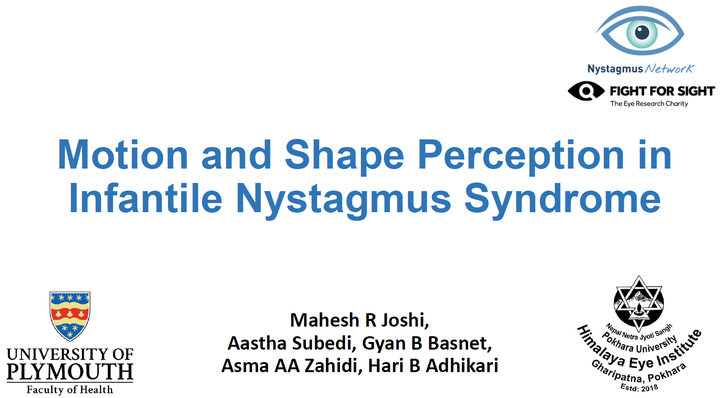Talk presentation at International Nystagmus Symposium 2024
Talk presentation at International Nystagmus Symposium 2024

On 25th October 2024, I presented a talk on ‘Motion and shape perception in infantile nystagmus syndrome’ at the International Nystagmus Symposium. The talk was well received and there was lively discussion following the presentation. This study was conducted in collaboration with researchers from the Himalayan Eye Hospital, Pokhara, Nepal. The Abstract can be accessed below and the slides from the pdf button above:
Abstract
Background: Nystagmus results in reduced sensitivity to a wide range of visual functions. These deficits are a result of retinal image blur due to excessive eye movements and cortical changes from early visual deprivation. We measured motion and shape sensitivity in infantile nystagmus to 1. compare deficits between motion and shape domain and 2. decipher the role of internal noise (related to local deficit such as eye movement) and sampling efficiency (global cortical deficit).
Methods: 30 participants (14.40 ± 4.83 years) with infantile nystagmus syndrome and 30 age-matched controls discriminated the direction of motion and orientation (rightward vs leftward) of physically equivalent translational random dot kinematograms (RDK) and Glass patterns. Two experimental paradigms were employed: coherence threshold (random noise) and equivalent noise (@ 5 noise levels).
Results: The mean coherence thresholds for translational motion were higher in the nystagmus group (50.55%±21.33, 31.87%±14.69) compared to controls (24.04%±13.22, 20.65%±12.89) at 5°/s and 10°/s speeds (p<0.01). The mean orientation coherence thresholds were also higher for the nystagmus group (12.23%±6.32 vs. 7.88%±4.33), p<0.01. Similarly for the equivalent noise paradigm, thresholds were higher for nystagmus group at 4 noise levels (p<0.01), but similar at the highest noise level (p>0.01). The discrimination thresholds fitted to linear amplifier model to determine the contribution of internal noise and sampling efficiency showed that for both motion and orientation the change in internal noise best explained the difference in performance (p >0.05).
Conclusion: The nystagmus group showed lower sensitivity to both motion and orientation perception. These deficits could be related to higher internal noise due to excessive retinal motion from abnormal eye movement and changes in early cortical areas.
Acknowledgement: The stimulus development of this project was supported by the Fight for Sight Nystagmus grant (SGANYN 2209) to authors MRJ and AAAZ.